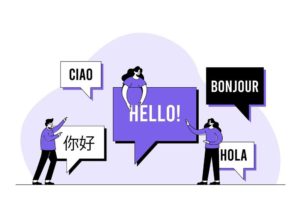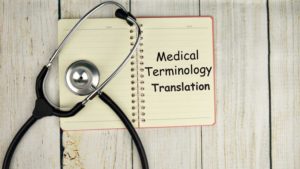Imagine a scenario where a patient arrives at a hospital, visibly distressed and in need of urgent medical attention. The catch? They speak a language that the attending healthcare professionals do not understand.
This language barrier could prove life-threatening if critical information is lost in translation. This is where medical interpreter apps come to the rescue, facilitating a lifesaving conversation and transforming the way healthcare providers diagnose and treat patients from diverse linguistic backgrounds.
Why Do We Need Medical Interpreter Apps
According to the U.S. Census Bureau, approximately 25 million people in the United States have limited proficiency in English. This demographic faces significant challenges when seeking healthcare services.
Consider this scenario: A non-English-speaking patient arrives at a hospital, experiencing severe abdominal pain. They are unable to convey their symptoms to the medical staff, leading to confusion and potential misdiagnosis.
This is where medical interpreter apps step in. They serve as a bridge between the patient and healthcare provider, ensuring that the patient’s symptoms and medical history are accurately communicated, leading to a more precise diagnosis.
Some of the main reasons why you need a medical interpreter app to help diagnose a patient are.

- Breaking Language Barriers
- Enhancing Doctor-Patient Communication
- Improving Patient Outcomes
1. Breaking Language Barriers
Imagine a scenario where a patient with limited English proficiency is rushed to the emergency room, experiencing excruciating chest pain. Language becomes a formidable barrier to comprehending the nature and severity of the pain.
In such critical moments, the immediacy of medical attention is paramount. However, without an effective means of communication, medical staff may struggle to understand the patient’s symptoms and medical history.
This can lead to delayed diagnosis and treatment, potentially putting the patient’s life at risk. Here, the significance of medical interpreter apps becomes evident. These apps break through language barriers, providing an instant channel of communication.
2. Enhancing Doctor-Patient Communication
Effective doctor-patient communication is fundamental to quality healthcare. When language barriers exist, this communication can be seriously compromised.
Medical interpreter apps, however, act as mediators in these interactions. They facilitate clear and empathetic communication, ensuring that patients can express their thoughts and receive explanations about their medical condition in their preferred language.
3. Improving Patient Outcomes
For patients, improved outcomes are the ultimate goal of any medical intervention. Without the aid of medical interpreter apps, consider a situation where a healthcare provider misunderstands a patient’s symptoms due to a language barrier.
This misunderstanding can lead to misdiagnosis and the application of inappropriate treatments, which can have adverse effects on the patient’s health. Medical interpreter apps, on the other hand, significantly reduce the likelihood of such errors.
How the Medical Interpreter App Works
Medical interpreter apps are sophisticated tools designed to bridge language gaps in healthcare settings. They operate through a combination of advanced technology, artificial intelligence, and user-friendly interfaces. Here’s a detailed explanation of their operation:
1. Real-Time Translation
Picture a doctor trying to explain a complex medical procedure to a patient who speaks a different language.
With a medical interpreter app, the doctor can speak, and the app translates their words in real time.
This instantaneous translation ensures that the patient fully comprehends the procedure, risks, and benefits, allowing them to make informed decisions about their healthcare.
2. Multi-Language Support
In a diverse and multicultural healthcare setting, patients may come from various linguistic backgrounds.
Medical interpreter apps offer support for a wide range of languages, from Spanish and Chinese to less commonly spoken languages like Swahili or Tagalog.
This extensive language support ensures that healthcare providers can effectively communicate with patients, regardless of their native tongue.
Why Adopting Medical Interpreter App in Healthcare is Vital

Imagine for a moment that you’re in a foreign country, facing a medical issue. You’re already worried about your health, and the language spoken by the healthcare professionals is unfamiliar to you.
In such a situation, you may find yourself lost in translation, unable to express your symptoms, and concerns, or understand the diagnosis and treatment options.
This scenario underscores the critical role that medical interpreter apps play in healthcare. These innovative tools break down language barriers, making healthcare more accessible and effective for everyone.
But why should healthcare institutions seriously consider adopting these apps? Well here is the reason why healthcare institutions adopt medical interpreter apps.
- Inclusivity: By integrating medical interpreter apps, healthcare institutions send a powerful message: they are committed to inclusivity. Language should never be a barrier to receiving quality healthcare, and these apps make sure it isn’t.
- Better Outcomes: Effective communication is directly linked to better healthcare outcomes. When patients and healthcare providers can understand each other, diagnoses are more accurate, and treatments are more effective.
- Cultural Sensitivity: Healthcare isn’t just about physical symptoms; it’s also about understanding the cultural context of a patient’s health concerns. Medical interpreter apps help bridge these cultural gaps, promoting more sensitive and effective care.
- Efficiency: Traditional methods of in-person interpreters or telephone interpretation can be time-consuming and costly. Medical interpreter apps streamline the communication process, saving time and resources.
Applications of Medical Interpreter App in Healthcare
Medical interpreter apps are versatile tools, playing a vital role in diverse healthcare scenarios. From emergency situations to telemedicine, these apps facilitate clear communication, ensuring accurate diagnoses and improved healthcare accessibility.
Two of the main applications of medical interpreter apps in the healthcare sector are.
- Emergency Situations
- Remote Consultations
1. Emergency Situations
In a high-stress environment like an emergency room, every second counts. Now, visualize a scenario where a patient with a life-threatening condition arrives, and the medical team cannot understand their symptoms due to a language barrier.
Medical interpreter apps provide quick and efficient language assistance, ensuring that vital information is conveyed accurately and rapidly, potentially saving lives.
2. Remote Consultations
Imagine a patient who cannot visit a healthcare facility in person due to distance or health concerns. Telemedicine has become increasingly popular, and medical interpreter apps play a crucial role in enabling remote consultations.
Patients can connect with healthcare providers from the comfort of their homes, regardless of language barriers, ensuring that no one is left without the medical care they need.
The Future of Medical Interpreter Apps
Medical interpreter apps are poised for significant growth and development in the coming years, and this growth is supported by various data and trends:
- Increasing Demand for Multilingual Healthcare
- Integration with Electronic Health Records (EHR)
- Global Expansion of Telemedicine
1. Increasing Demand for Multilingual Healthcare
According to the U.S. Census Bureau, over 20% of the U.S. population speaks a language other than English at home. This demographic trend is mirrored in many other countries, creating a growing need for multilingual healthcare services.
It is not possible for human interpreters to cover this huge gap and the need for medical interpreters will only increase.
3. Integration with Electronic Health Records (EHR)
The integration of medical interpreter apps with electronic health records (EHR) systems is a critical development.
Research by Markets and Markets suggests that the global EHR market was estimated at $26.5 billion in 2020 and is expected to reach $39.7 billion by 2025, with a CAGR of 8.4%. This means that the future of medical interpreter apps is brighter.
3. Global Expansion of Telemedicine
The COVID-19 pandemic accelerated the adoption of telemedicine. According to McKinsey, in the United States, telehealth utilization surged from 11% of consumers in 2019 to 46% in 2020. As telemedicine expands, the need for language assistance in remote consultations is likely to rise.
Conclusion
Medical interpreter apps are revolutionizing healthcare by breaking down language barriers and improving the quality of patient care. As technology advances, we can expect these apps to play an even more significant role in providing seamless communication between healthcare professionals and their patients.







